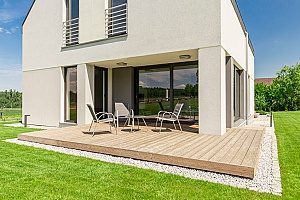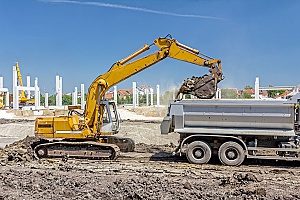 If you are interested in changing up the appearance of your yard, starting a landscaping project is a great way to do so. There are tons of projects you can do such as building a waterfall, planting a garden, or changing up the terrain of your yard. One way you can change up your landscape is to terrace your yard. This will create dimension and endless possibilities for you to be creative with design. They can be decorated with stones, plants, flowers, or even turned into a waterfall. Building a terrace is relatively simple, you just need the help of a little Maryland fill dirt. Maryland fill dirt is necessary to have the most successful terracing project because of the unique composition that makes it extremely reliable and sturdy.
If you are interested in changing up the appearance of your yard, starting a landscaping project is a great way to do so. There are tons of projects you can do such as building a waterfall, planting a garden, or changing up the terrain of your yard. One way you can change up your landscape is to terrace your yard. This will create dimension and endless possibilities for you to be creative with design. They can be decorated with stones, plants, flowers, or even turned into a waterfall. Building a terrace is relatively simple, you just need the help of a little Maryland fill dirt. Maryland fill dirt is necessary to have the most successful terracing project because of the unique composition that makes it extremely reliable and sturdy.
Using Maryland Fill Dirt for Land Grading
One of the major parts of the building is terrace involves land grading. Typically land grading is used to make the landscape more level so that things like buildings or roads can be built on top of it. In this case, you going to use land grading to add dimension to your yard by building up certain areas or filling them in. This is one of the major steps in terracing your yard because not only will it act as a strong foundation for the terrace, but it will have a heavy impact on the final appearance of the terrace.
To best use Maryland fill dirt, you need to understand why it’s composition makes it ideal for your landscaping project. The two big types of dirt that most people choose for their projects are fill dirt and topsoil. Both have very different compositions and therefore have very different uses. Topsoil is essential for gardening or farming because this type of nutrient-rich dirt helps plants thrive. However, if fill dirt is used for a farming project, plants would have a very difficult time growing because fill dirt lacks the necessary nutrients. Fill dirt is primarily used for construction purposes such as building foundations or land grading. If topsoil is used for foundations or land grading, the project won’t be successful because topsoil contains organic matter that breaks down over time. This will result in the volume of the topsoil changing, which could then potentially cause any foundations on top to shift. This is also a problem when it comes to land grading because if you are trying to fill a low point, the low point may be initially filled to be level with the rest of the land, but over time the changing volume of the topsoil will result in the low point returning.
 Understanding the different types of dirt is essential to the success of your project. If you just use the dirt in your yard to build up your terrace, you’re going to run into problems as it’s most likely that you will be using topsoil. Maryland fill dirt has also been tested and certified so that you know it doesn’t contain any toxins or large debris.
Understanding the different types of dirt is essential to the success of your project. If you just use the dirt in your yard to build up your terrace, you’re going to run into problems as it’s most likely that you will be using topsoil. Maryland fill dirt has also been tested and certified so that you know it doesn’t contain any toxins or large debris.
Preparation
The very first step in starting your project is to choose where you want the terrace to go. If you have a natural hillside or slope in your yard, you might want to use that to your advantage. However, if you don’t, you can create one with the help of Maryland fill dirt. You just have to place it and compact it in the area you want it along with making sure the size and slope are similar to what you want the end result to look like.
Digging a Trench
To get started on your terracing project, you have to dig a trench along the horizontal base of the hillside you either naturally have or have created. You need to make sure that the trench is as level as possible across its entire length. If your terrace isn’t level initially, which is most likely, use Maryland fill dirt to fill in areas that need to be raised, and cut away any areas that may be too high. Don’t speed through this step, as it’s important in making sure your terrace turns out great in the end.
Landscape Timber
The next step is to measure the length of your trench with a measuring tape. Then you’re going to have to cut a landscape timber with a saw that is the same length as your trench. If your landscape timber can’t reach the full length on its own, all you have to do is cut additional timbers to match the length of the trench.
 Lay the landscape timber into the trench. If your trench is longer than one timber and you have to use additional pieces, just make sure you lay them down so they are touching end to end. This will complete the retaining wall base of your terrace, which will also act as a strong base that allows you to have a final 12-24 inch deep terrace for various vegetables or other plants.
Lay the landscape timber into the trench. If your trench is longer than one timber and you have to use additional pieces, just make sure you lay them down so they are touching end to end. This will complete the retaining wall base of your terrace, which will also act as a strong base that allows you to have a final 12-24 inch deep terrace for various vegetables or other plants.
Cutting Into the Hillside
Cut two 90-degree-angle trenches at opposite ends of the first trench into your hillside. This should leave you with three defined edges of your terrace at this point in your project. If you’re going to use your terrace for planting space, make sure there is a two-foot height difference between each terrace so you have a proper amount of space to plant.
Continue cutting into the hillside with the two trenches until they are deeper than your timber’s diameter by one inch. Just like with the first trench, ensure that its level and then place in landscaping timbers.
Final Steps
Install galvanized metal spiles into the landscape timbers with a hammer. Use a minimum of three spikes per timber, depending on the length of the wood. These spikes are what secure the wood to the ground. Add another layer of landscape timbers to the base wood, ensuring that the wood is staggered like bricks for the most stability. Again, insert three spikes into the wood. Make sure to place them in the same place as the base timber.
Next, use Maryland fill dirt to fill in the area. This can usually be provided through a Maryland fill dirt delivery service. Make sure the area is level, and do your best to have a slight slope of two percent from side to side to move water away from the timbered step ends and into side drainage areas. Then decorate it however you want to enjoy the beauty of your brand new terrace.









































